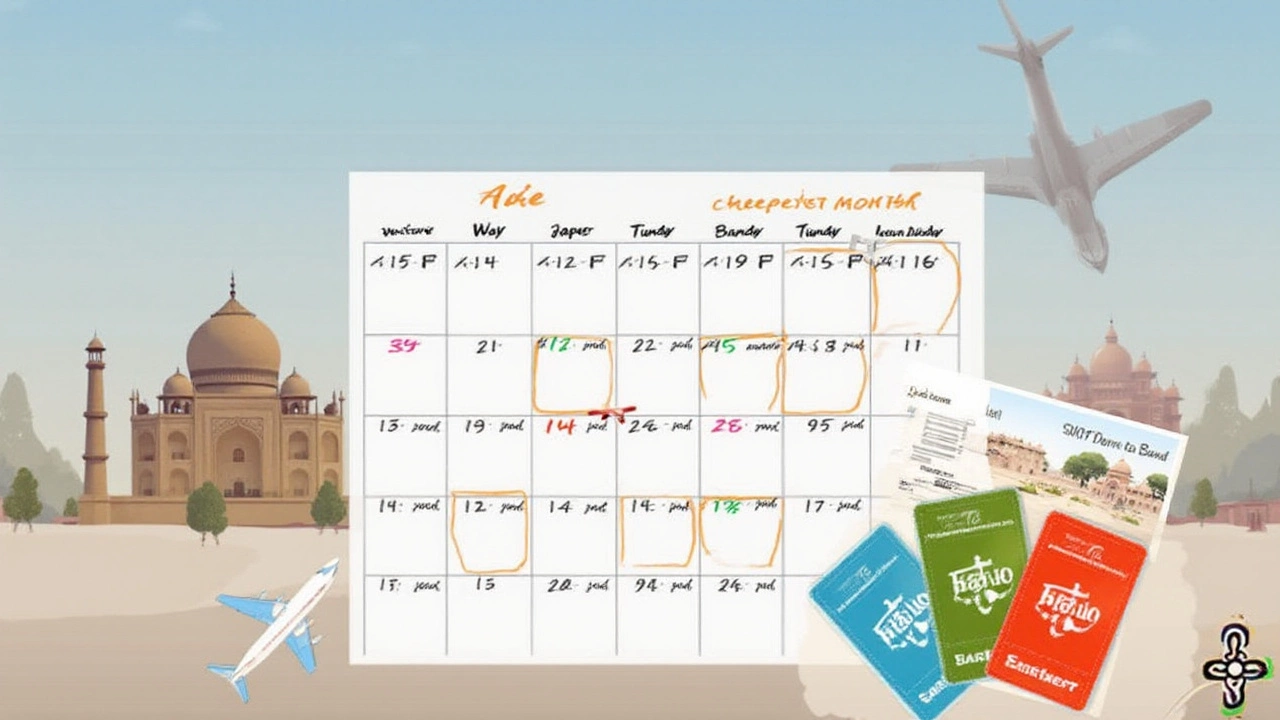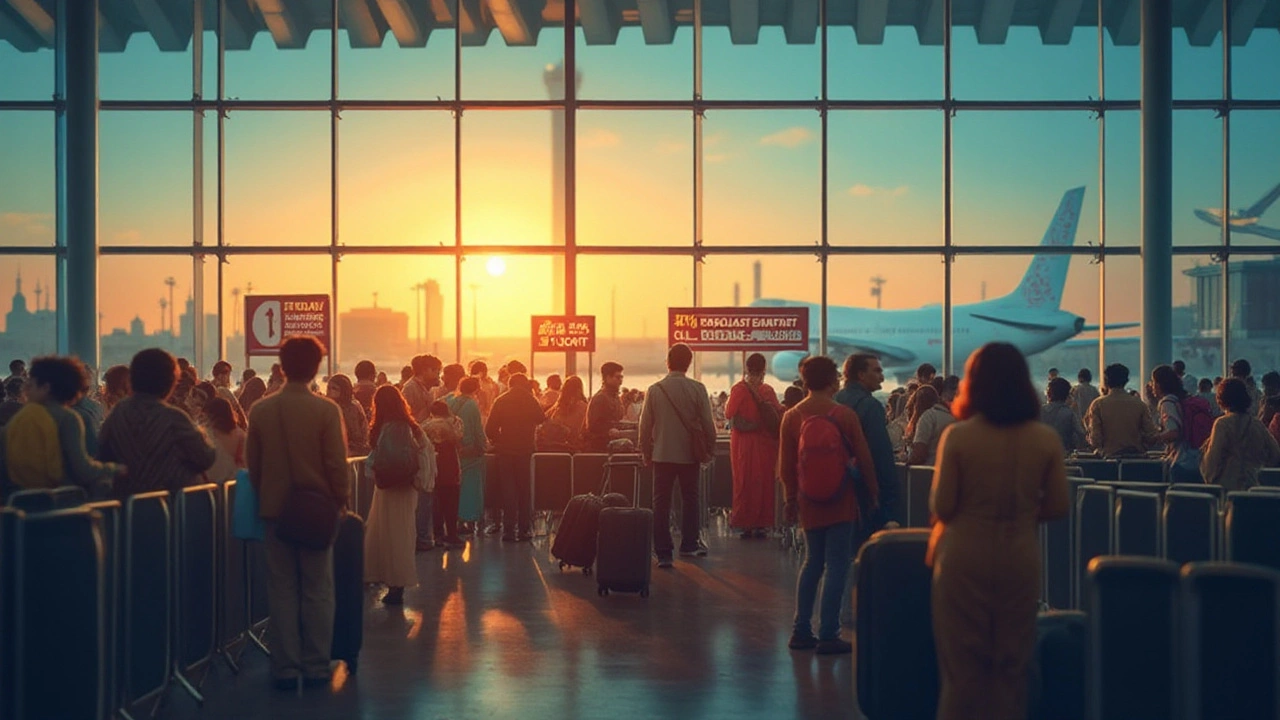Finding a pocket-friendly flight to India from the USA is like discovering a hidden gem. If you're planning an exciting journey to the vibrant lands of India on a budget, picking the right month to fly can make all the difference. Flight prices can vary significantly depending on the season, demand, and even the day of the week.
Many savvy travelers focus on understanding seasonal trends and booking strategically. Knowing when flight costs hit their lowest is key to saving big on international travel. In this article, we'll dive into the optimal time to purchase those hard-to-find cheap tickets and share tips to ensure you snag a great deal.
- Understanding Airfare Trends
- Best Time to Book Flights
- Travel Seasons in India
- Tips for Finding Cheap Flights
- Budget Airlines vs. Traditional Carriers
- Maximizing Savings While Traveling
Understanding Airfare Trends
To unlock the secret to cheap flights from the USA to India, it's crucial to dive into the rhythmic patterns governing airfare trends, often described as the magic of supply and demand. Airlines, akin to seasoned market analysts, adjust their prices to balance seats and revenue. This balancing act makes airfare fluctuating and somewhat unpredictable, but all hope isn't lost for the budget-conscious traveler. By tapping into historical data, you can unearth patterns that provide a glimpse into future fare predictions.
One enduring pattern is the seasonal fluctuation in prices. Flights to India, usually expensive during peak tourist seasons like December and early January, become more affordable in off-peak months. Analyzing past airfare data reveals that September tends to emerge as a cheaper month due to the transition from the summer travel season to a quieter period. This time, characterized by lower demand, often results in slashed prices as airlines aim to fill seats.
Influence of Global Events
A less obvious but significant aspect of airfare trends is the influence of global events, including festivals, holidays, and geopolitical happenings. These can dramatically sway travel demand, leading to sudden price jumps or drops. For instance, during significant Indian festivals such as Diwali, airfares can spike. Conversely, during non-holiday months, travelers can expect lower prices. Consider this a dance between global movements and shifts affecting travel demand and airline pricing strategies.Digital age technology plays a fascinating role too. Budget travel aficionados can use AI-predictive tools to navigate through possible price changes, allowing for informed booking decisions. Price prediction apps, gaining ground in recent years, are used by travelers to anticipate the best days to snag low fares. This emergence of travel technology equips travelers with tools to almost foresee airfare movements like a seasoned oracle. As cited by a 2022 study in "Travel Weekly," these predictive tools boast an accuracy of around 75%.
"With artificial intelligence, travelers stand a better chance at booking lower fares, as predictive technology reads into market patterns akin to a crystal ball."
Grasping airfare trends involves a considerable understanding of market dynamics. While it sounds complex, frequent travelers gradually learn to anticipate changes—a skill that pays off over time. Whether it's by tracking historical fare data, keeping an eye on global events, or employing digital tools, understanding airfare trends is an art and science that allows travelers to embark on a budget travel adventure from the USA to India with confidence.
Best Time to Book Flights
Booking flights can sometimes feel like navigating a maze, more so when hunting for that elusive budget ticket to India from the USA. Experts often advise booking international flights between two to three months out for the best deals, and this rule of thumb holds true for travel between these two vibrant destinations. The months of August to October are typically the most cost-effective for traveling to India. During these months, the monsoon season wraps up, causing a dip in tourist traffic, which airlines generally respond to by lowering prices. It's a well-known fact in the travel industry that flights booked during this off-peak season can save travelers a significant amount of money.
Travel insiders often recommend flying during weekdays, particularly on Tuesdays and Wednesdays, as airlines frequently offer their best deals at the start of the week. These are the days when many airlines update their ticket prices, which can result in unbeatable deals if you keep a keen eye on flight comparison websites. It's also wise to avoid flying during festive periods like Diwali or Christmas, as these holidays tend to drive prices up due to increased demand. A lesser-known strategy involves tracking flight prices on multiple platforms and setting up fare alerts to catch price drops in real time. Speaking of the best time to secure flights, some believe in the Golden Hour tactic, booking precisely around noon when there might be a greater variety in available seats and prices.
"Skyscanner has observed a tendency for flights to be 15% cheaper if booked 20 weeks ahead," notes a travel analyst from Skyscanner, a leading flight comparison website.
For data enthusiasts, here's a glimpse at how your savings might look if you book at an opportune moment:
| Booking Lead Time | Potential Savings |
|---|---|
| 1-2 months in advance | 5% - 10% |
| 2-3 months in advance | 10% - 20% |
| 3-4 months in advance | 12% - 25% |
These recommendations are meant to guide you toward more substantial savings on your journey to India. In a travel scenario where flexibility is just as crucial as timing, having a range of possible dates for departure and return can offer the best window for scooping up cheap flights. At the end of the day, patience and due diligence can be your best allies in securing the most affordable journey from the USA to India.

Travel Seasons in India
India's vast and diverse landscape means that every region dances to its own seasonal rhythm, creating a symphony of climates and cultural festivals. Three primary seasons guide the travel narrative across the Indian subcontinent: summer, monsoon, and winter. Each season brings its unique beauty and challenges, influencing both the experience on the ground and the dynamics of flight pricing.
The summer months, stretching from April to June, blanket most of India with a searing sun. Regions like Rajasthan transform into hot cauldrons, with temperatures often soaring above 40 degrees Celsius. However, this sweltering heat also means sparser tourist crowds, making it an excellent time for those looking to explore infinity locales without jostling for space. This off-peak period tends to offer cheaper flights and accommodation, especially in the northern parts of the country.
“India is best experienced when you let go of preconceived notions about comfort and dive deep into the chaos and charm it offers,” notes travel expert Rick Steves.
As the summer draws to a close, the monsoon rains arrive almost like clockwork, usually beginning in June and lasting through September. The monsoon season brings lush greenery and a cooler climate, particularly in the southern and western states. Travelers can revel in the magic of the rains, especially in Kerala and Goa, where the landscape transforms into a verdant paradise. However, the heavy rains can also lead to delays and cancellations, so plan accordingly if traveling during these months.
Winter, from October to February, is arguably the most favored travel season in India. During these cooler months, destinations like Delhi, Agra, and Jaipur are truly at their best, offering pleasant weather perfect for exploration. The winter season is also the time for many festivals, adding a vibrant touch to the traveler's experience. However, this peak time attracts a higher number of tourists, leading to increased demand and subsequently, higher flight prices.
Tips for Planning Around Travel Seasons
- To truly embrace budget travel to India, consider planning your trip for the shoulder seasons, right at the cusp of weather changes, where you can enjoy mild climates and more affordable airfare.
- Research local events and national holidays, as these can considerably impact flight prices and availability.
- Keep an eye on flight flash sales, which airlines typically offer during off-peak months to boost travel.
Being aware of India's travel seasons allows you to strategically plan your adventure, ensuring a memorable and cost-effective journey that's filled with immersive experiences and delightful discoveries.
Tips for Finding Cheap Flights
Finding those coveted cheap flights to India from the USA requires a bit of strategy and a sprinkle of patience. Timing, flexibility, and using the right tools can be the keys to unlocking a more economical travel experience. Many travelers might be aware that booking well in advance can sometimes result in more savings. Ideally, starting your search six to eight months before your intended departure can be beneficial. Certain flight comparison websites offer tools and alerts that can track price trends over time, alerting you when it's best to make your purchase. In an era where digital tools reign supreme, travelers have access to countless options to compare and contrast various airlines and routes, ensuring they have the most favorable options front and center.
One tip many overlook is considering alternate airports for departure or arrival. Flying into or out of nearby cities might present lesser-known routes that are more wallet-friendly. Additionally, booking flights for mid-week departures typically yields lower rates than weekend travel, as business travelers mostly commute on weeks starting and ending days. According to the historical data from CheapAir.com's Annual Airfare Study, Tuesdays and Wednesdays generally offer the lowest fares. Aerodynamically, planes with more passengers burn more fuel, affecting ticket prices. This is just one reason why flights during school holidays, Christmas, and New Year, often skyrocket in price. Adjusting your travel dates by just a few days could lead to substantial savings.
Utilizing Flight Alerts and Comparisons
Flight comparison websites like Google Flights or Skyscanner offer users the ability to set up alerts that notify them when prices drop for specific itineraries. These alerts can help capture lower rates as airlines periodically adjust their pricing based on factors like supply and demand.
"The early bird catches the worm — or in this case, the deal," says Patrick Surry, Chief Data Scientist at Hopper. When travelers take proactive steps like setting fare alerts, they position themselves to capitalize on temporary price drops.Yet, while comparison sites are invaluable, they should be used alongside official airline sites, as airlines might occasionally offer exclusive discounts when booking directly through their site.
Another savvy approach for securing budget travel is to remain flexible with your flight routes. While direct flights are convenient, they're not always the cheapest option. Connecting flights, although potentially longer, might save you a significant amount of money. It's worth checking if taking a slightly longer journey with layovers could be the key to traveling at a fraction of the cost. So, what does that look like? Consider a detour through Europe or the Middle East, where layovers might present an opportunity not only for savings but for bonus adventures.
Consider All-Inclusive Flight Packages
At times, booking flights in conjunction with hotels or cars as part of a package can lead to additional savings. Many travel websites or corporate travel portals offer bundled deals, reducing the overall cost. It might seem counterintuitive, but spending on a flight and a hotel under a single transaction may give you a more affordable rate compared to booking each separately. Additionally, take a moment to explore potentially valuable student or senior discounts if they apply. Lastly, joining and accumulating miles via frequent flyer programs could translate to reduced airfare for future trips, a perk not to be underestimated for devoted travelers. With these practical tips and strategies, navigating the skies towards budget-friendly travel isn't just an aspiration—it's completely achievable.

Budget Airlines vs. Traditional Carriers
When planning a trip to India from the USA, travelers often face a pivotal choice between budget airlines and traditional carriers. While each option has its pros and cons, the decision ultimately hinges on your travel preferences and budget. Budget airlines are renowned for their low-cost tickets and often lure customers with irresistible discounts, perfect for those aiming for budget travel India. On the other hand, traditional carriers might offer a more luxurious experience with added comforts that are sometimes lacking in budget options.
Budget airlines typically offer point-to-point flights and focus on minimizing costs by eliminating many of the frills associated with air travel, such as complimentary meals or reclinable seats. They often fly to secondary airports, which can be further from your ultimate destination, potentially saving fees but adding ground travel inconvenience. This model allows these carriers to offer some of the lowest prices available, making them a go-to option for the savvy traveler. However, be prepared for extra charges; budget airlines often offset their initial low pricing with fees for checked baggage, seat selection, and even water on board.
Traditional carriers, although slightly pricier, provide services that many travelers find invaluable. These services may include a more generous baggage allowance, meals during long-haul flights, and in-flight entertainment, which can make the journey feel less taxing. They also offer multiple flight times and direct flights to major airports, reducing layovers and travel time. Traditional airlines might not need to charge extra for basic amenities, making for a smoother and potentially cheaper experience when all fees are considered in full scope.
An illuminating quote from a senior analyst at a leading travel consultancy states:
"The real value in choosing between budget and traditional airlines lies in understanding the hidden costs and your personal priorities for comfort and convenience during travel."In practice, many travelers have found that occasional sales or promotional offers by traditional airlines can match – or even beat – the total cost of a budget airline ticket when all additional fees are accounted for. Therefore, it pays to compare all options available.
Considerations like frequent flyer programs also come into play when evaluating your carrier choice. Many traditional carriers offer reward points that can be redeemed for future travel or upgrades, a feature that budget airlines might not always provide. Loyalty programs can prove significant for frequent travelers, tilting the balance in favor of traditional carriers. Whatever your ultimate choice, ensuring you know what each option offers can lead to wiser, well-informed decisions that keep your wallet and your travel experience intact.
Maximizing Savings While Traveling
Traveling to India doesn't need to break the bank, especially when you strategize properly to save money during your trip. One tried-and-true approach is to book your accommodations well in advance. By securing a place to stay early, you can often take advantage of early bird discounts and lock in the best rates available. Consider budget-friendly options like hostels or homestays, which not only save money but also offer the chance to connect with locals and other travelers, enriching your journey in immeasurable ways. Having a flexible itinerary can also yield significant savings, letting you flow with opportunities that present themselves.
Public transportation in India is incredibly affordable and can be an adventure all on its own. The trains, though crowded, are an iconic way to travel across the country. They offer different classes so you can choose what best fits your budget and comfort level. Buses are another worthwhile option, allowing access to even the most remote locations without significant cost. When purchasing tickets, it’s wise to plan ahead, especially during peak travel seasons. Sometimes, sharing rides with others using apps can provide both savings and a chance to make new acquaintances.
Dining in India can be one of the more affordable aspects of your travel budget if done wisely. Street food is not only economical but also provides an authentic taste of local flavors. From spicy chaat in Delhi to dosas in the south, your taste buds will be delighted, and your wallet will thank you. However, always ensure you choose street vendors that appear clean and frequented by locals to avoid any health issues. Cooking your own meals occasionally, if your accommodation allows it, can also curb expenses significantly.
Currency exchange rates can fluctuate, affecting how far your dollars will stretch. Keeping an eye on exchange rate trends or using a currency exchange app can alert you to the best times to convert your money. It's generally advisable to exchange a small initial portion of your dollars at the airport for immediate expenses and then seek better rates at banks or reputed exchange offices for larger sums. Always steer clear of exchanging currency in tourist-heavy areas, where the rates might not favor the traveler.
While planning your itinerary, include a balance of high-profile attractions and little-known destinations. Entry fees to major sites can add up quickly, but India's plethora of free or low-cost wonders — from breathtaking beaches to sacred temples — can allow you to experience the country's rich culture and history on a budget. Engaging in local festivals, which often feature lively marches, music, and food, is another way to absorb the vibrancy of Indian life without emptying your pockets.
The all-important travel insurance is another area not to skimp on, as unforeseen circumstances can incur costs far exceeding the insurance fee. For instance, a comprehensive policy can cover potential medical expenditures or provide assistance when flights get canceled. These expenses, when not planned for, might derail your financial planning. As Lonely Planet suggests, "Smart travelers know that cutting insurance is like going to sea without a life-jacket.” Invest some time comparing policies to ensure you get the best coverage for your needs at a reasonable cost.
